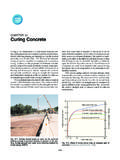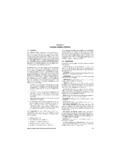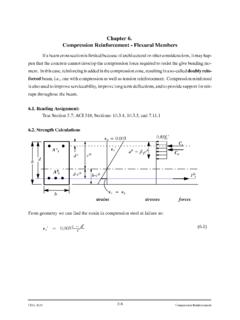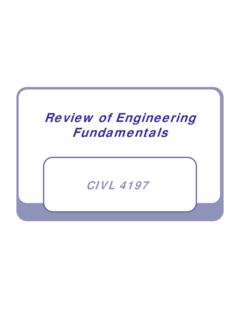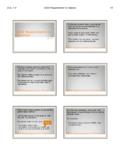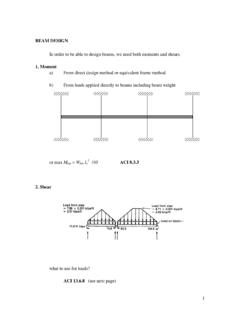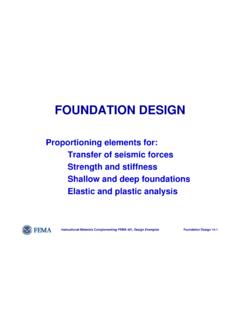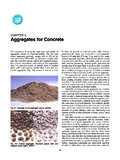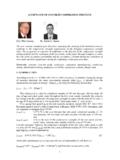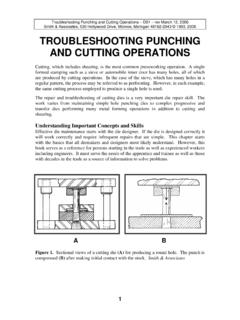Transcription of Designing Concrete Mixtures - Department of Civil …
1 Designing Concrete MixturesThere are three phases in the development of a Concrete mixture: specifying, Designing , and proportioningDesigning Concrete MixturesThere are three phases in the development of a Concrete mixture: specifying, Designing , and proportioningACI Mix Design The most common method used in North America is that established by ACI Recommended Practice Any mix design procedure will provide a first approximation of the proportions and must be checked by trial batches. Local characteristics in materials should be considered.
2 The following sequence of steps should be followed: (1) determine the job parameters - aggregate properties, maximum aggregate size, slump, w/c ratio, admixtures, (2) calculation of batch weight, and (3) adjustments to batch weights based on trial mix. Water/cement ratio (w/c ratio) theory states that for a given combination of materials and as long as workable consistency is obtained, the strength of Concrete at a given age depends on the w/c ratio. The lower the w/c ratio, the higher the Concrete strength. Whereas strength depends on the w/c ratio, economy depends on the percentage of aggregate present that would still give a workable mix.
3 The aim of the designer should always be to get Concrete Mixtures of optimum strength at minimum cement content and acceptable workability. ACI Mix DesignACI Mix DesignACI Mix DesignAir-Entrained Concrete One of the greatest advances in Concrete technology was the development of air-entrained Concrete in the late 1930s. Today, air entrainment is recommended for nearly all concretes, principally to improve resistance to freezing when exposed to water and deicing chemicals. Air-entrained Concrete contains billions of microscopic air cells These relieve internal pressure on the Concrete by providing tiny chambers for the expansion of water when it freezes.
4 CIVL 1112 ACI Mix Design1/10 ACI Mix Design Once the w/c ratio is established and the workability or consistency needed for the specific design is chosen, the rest should be simple manipulation with diagrams and tables based on large numbers of trial mixes. Such diagrams and tables allow an estimate of the required mix proportions for various conditions and permit predetermination on small unrepresentative batches. ACI Mix DesignThe flowchart is a representation of the principal properties of good Concrete cement w/c ratio aggregate cement paste and aggregate mixing placement and handling of fresh Concrete curingACI Mix DesignBasic Considerations Economy-- The material costs are most important indetermining the relative costs of different mixes.
5 The labor and equipment costs, except for special concretes, are generally independent for the mix design. Since cement is more expensive than aggregate, it is clear that cement content should be minimized. This can be accomplished the lowest slump that will permit handling, a good ratio of coarse to fine aggregate, and use of Mix Design Workability-- A good mix design must be capable of being placed and compacted, with minimal bleeding and segregation, and be finishable. Water requirements depend on the aggregate rather than the cement characteristics.
6 Workability should be improved by redesigning the mortar faction rather than simply adding more water. Basic ConsiderationsACI Mix Design Strength and Durability-- In general, the minimum compressive strength and a range of w/c ratios are specified for a given Concrete mix. Possible requirements for resistance to freeze-thaw and chemical attack must be considered. Therefore, a balance or compromise must be made between strength and workability. Basic ConsiderationsACI Mix Design A measure of the degree of consistency and extent of workability is the slump.
7 In the slump test the plastic Concrete specimen is formed into a conical metal mold as described in ASTM Standard C-143. The mold is lifted, leaving the Concrete to "slump," that is, to spread or drop in 1112 ACI Mix Design2/10 ACI Mix DesignProcess of measuring the slump of fresh concreteACI Mix DesignProcess of measuring the slump of fresh concreteACI Mix DesignThis drop in height is the slump measure of the degree of workability of the Mix Design Here are some examples of different measures of slump:ACI Mix DesignThe flowchart is a representation of the principal properties of ACI mix design of Concrete workability slump water and air content w/c ratio cement coarse aggregate fine aggregate moisture adjustment trial mix ACI Mix DesignMix Design material information-- sieve analyses of both fine and coarse aggregates, unit weight, specific gravities, and absorption capacities of aggregates.
8 Of slump-- Generally specified for a particular job. However, if not given, an appropriate value may be chosen from Table 1. As a general rule, the lowest slump that will permit adequate placement should be selected. CIVL 1112 ACI Mix Design3/10 ACI Mix DesignTable 1. Recommended Slumps for Various Types of ConstructionACI Mix aggregate size-- The largest maximum aggregate size that will conform to the following limitations: Maximum size should not be larger than: 1/5 the minimum dimension of structural members, 1/3 the thickness of a slab, or 3/4 the clearance between reinforcing rods and forms.
9 These restrictions limit maximum aggregate size to inches, except in mass applications. Current thought suggests that a reduced maximum aggregate size for a given w/c ratio can achieve higher strengths. Also, in many areas, the largest available sizes are 3/4 in. to 1 Design ProceduresACI Mix of mixing water and air content-- An estimation of the amount of water required for air-entrained and non-air-entrained concretes can be obtained from Table 2. Mix Design ProceduresOne major disadvantage of Concrete is its susceptibility to damage by single or multiple freeze-thaw , Concrete can be made frost-resistant by using air-entraining admixtures.
10 Concrete is routinely air-entrained in the Northern and Canada. ACI Mix DesignApproximate mixing water ( ) and air content for different slumps and nominal maximum sizes of aggregatesMaximum aggregate size (in.)Slump(in) to 23503353153002752602201903 to 43853653403253002852452106 to 7410385360340315300270-Air ConcreteMix Design ProceduresACI Mix DesignMaximum aggregate size (in.)Slump(in) to 23052952802702502402251803 to 43403253052952752652502006 to 7365345325310290280270-Air Conte mixing water ( ) and air content for different slumps and nominal maximum sizes of aggregatesAir-Entrained ConcreteMix Design ProceduresACI Mix DesignMix Design ProceduresCIVL 1112 ACI Mix Design4/10 ACI Mix DesignMix Design ProceduresACI Mix ratio- This component is governed by strength and durability requirements(a)Strength -- Without strength vs.
